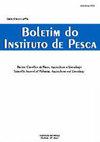Geographic information system as a tool for assessing ponds and the potential for environmental impact caused by fish farming
IF 0.6
4区 农林科学
Q4 FISHERIES
引用次数: 0
Abstract
The hydrographic basin of Arroio Marreco (Paraná State) concentrates a productive chain of fish farming and great intensification of tilapia farming. In this study, we aimed to monitor the quality of effluent water and organic and inorganic elements released by fish farming in ponds, using geomorphological and land-use and occupation data. The Terrain Analysis Using Digital Elevation Models, Digital Elevation Model software was used to delimit watersheds in the software Quantum geographic information system version 3.6.3. A total of 1,457 production units (water slides) were identified across the study area. This represented an occupied area of 160.2 ha. Analyzing the sub-basins, it was found that High Marreco is the sub-basin with the most developed logistical chain. Low Marreco does not yet have an integration of its fish farming with the region’s logistics chain. Medium Marreco does not have fish farming as its main activity, only using it to reuse inputs from other agricultural activities. There is a large input of nutrients from aquaculture in all the sub-basins. To reduce them, it is recommended to implement decantation and/or reuse of wastewater systems. The results of this study show how important it is to know the dynamics of nutrients in the fish farms and the physical characteristics of the drainage basin to determine the support capacity of the environment, so as not to allow licenses that promote impacts above the self-cleaning capacity of the courses water.利用地理信息系统评估池塘及养鱼对环境的潜在影响
阿罗约马雷科(paran州)的水文盆地集中了鱼类养殖的生产链和罗非鱼养殖的高度集约化。在本研究中,我们旨在利用地貌、土地利用和职业数据,监测池塘养鱼的出水质量以及有机和无机元素的释放。利用数字高程模型进行地形分析在量子地理信息系统3.6.3版软件中,采用数字高程模型软件对流域进行划界。整个研究区共确定了1457个生产单元(水滑梯)。这代表被占领的面积为160.2公顷。通过对子盆地的分析,发现高马雷科是物流链最发达的子盆地。下马雷科还没有将养鱼业与该地区的物流链整合起来。中马雷科不以养鱼为主要活动,只是利用它来重新利用其他农业活动的投入。所有子流域的水产养殖都投入了大量的营养物质。为了减少污染,建议将污水系统进行净化和/或再利用。这项研究的结果表明,了解养鱼场中营养物质的动态和流域的物理特征对于确定环境的支持能力是多么重要,这样就不会允许促进影响超过课程水的自清洁能力的许可证。
本文章由计算机程序翻译,如有差异,请以英文原文为准。
求助全文
约1分钟内获得全文
求助全文
来源期刊

Boletim do Instituto de Pesca
FISHERIES-ZOOLOGY
CiteScore
0.80
自引率
0.00%
发文量
24
审稿时长
>12 weeks
期刊介绍:
To publish original articles of research and short communications in the following áreas: Fisheries, Aquaculture, Zootechnology, Limnology, Oceanography, Biology and Pathology of aquatic organisms. The publication depends on the approval of the Editorial Board, based on the peer review.
 求助内容:
求助内容: 应助结果提醒方式:
应助结果提醒方式:


